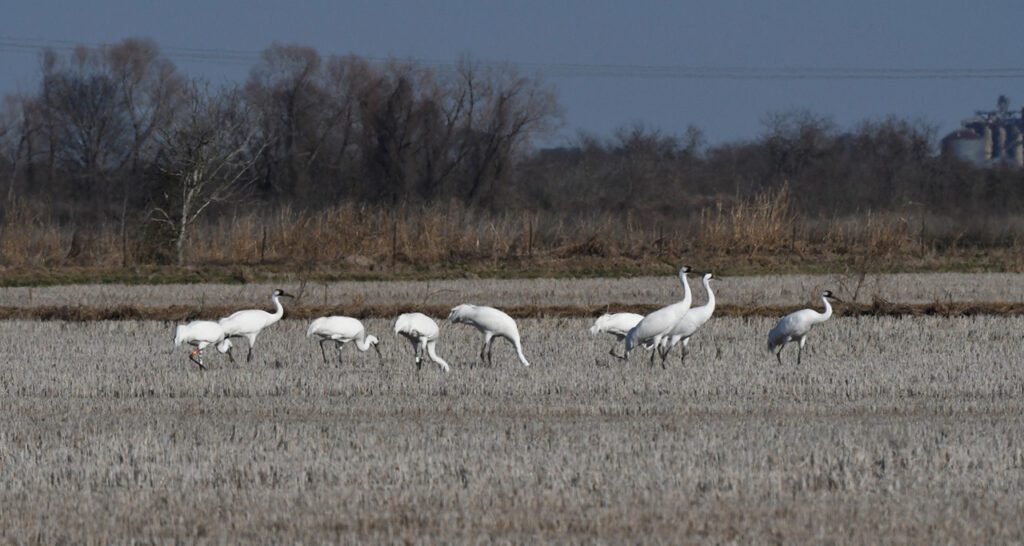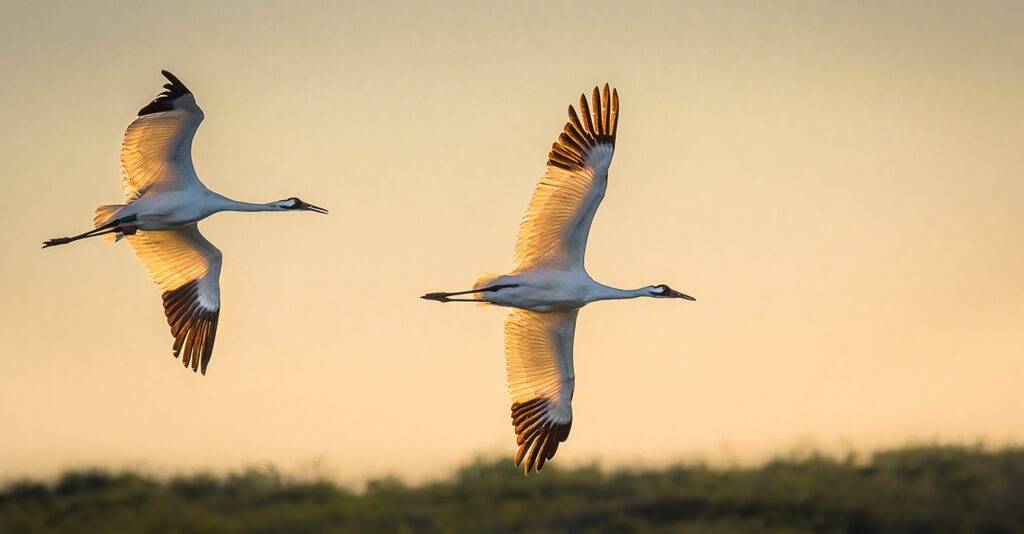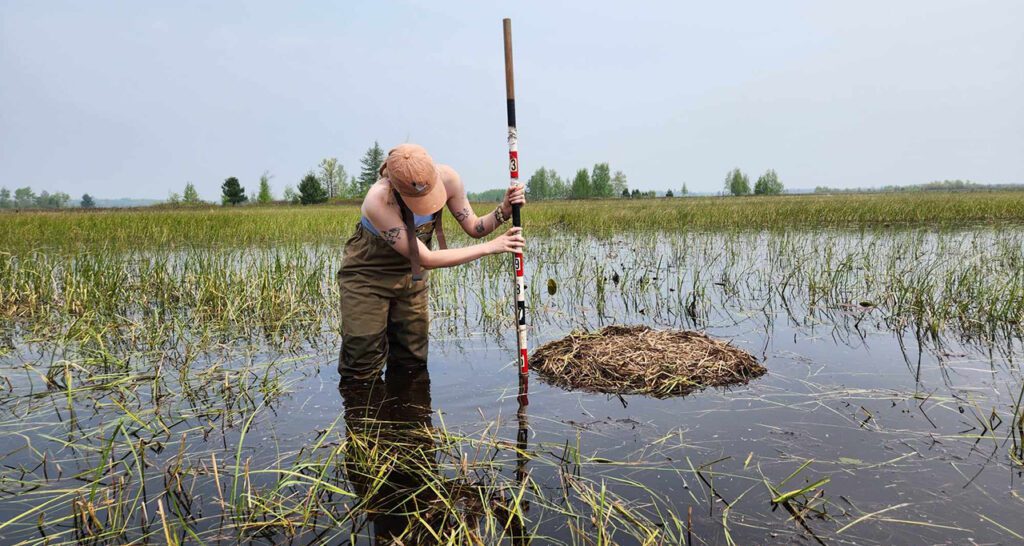Our Next Big Step in Whooping Crane Conservation
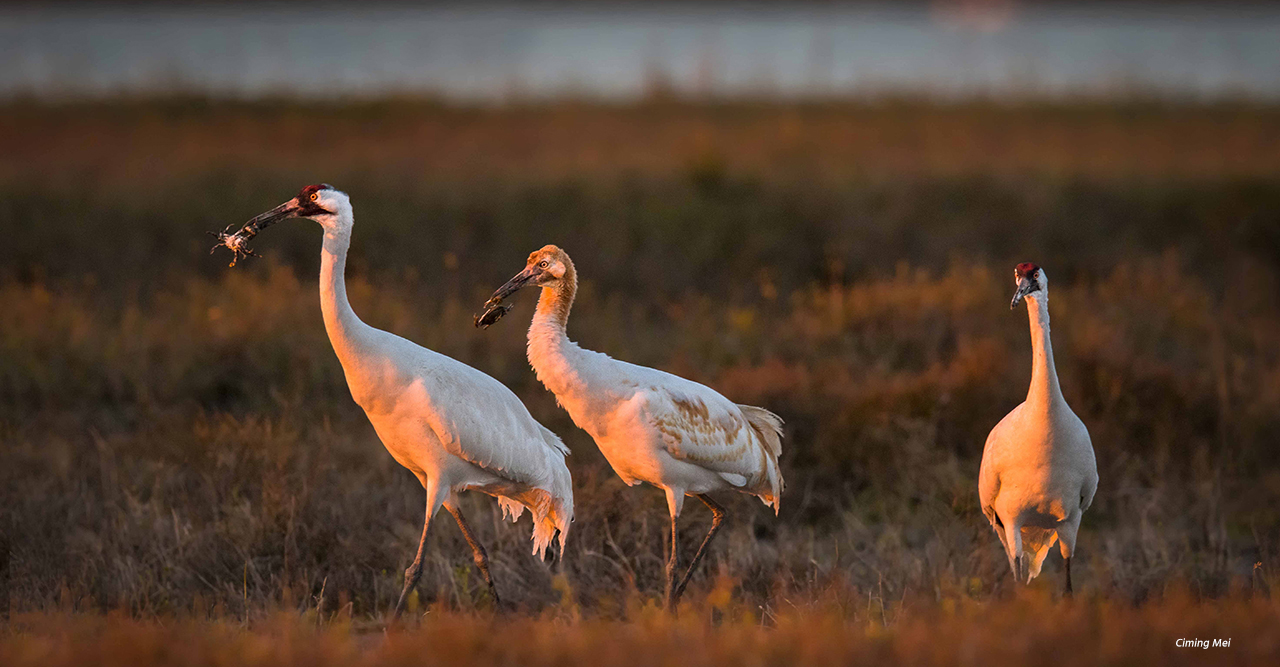
It’s a cool morning on the Texas coast. Flanked by a pod of dolphins cruising along the Crane Seeker, staff from the International Crane Foundation’s Gulf Coast Program approach one of the most important habitat areas for the endangered Whooping Crane.
Over the past 70 years, conservationists have come to understand the habitat needs of the last self-sustaining population of the species, the Aransas-Wood Buffalo Population. These rare and endangered birds breed in remote Northern Canada and winter on the Texas coast.
On their wintering grounds, they rely heavily on estuarine habitats like coastal salt marshes, which provide a necessary haven for the species to safely roost and feed on blue crabs, Carolina wolfberries, and mollusks. Though they now number just over 550 individuals, up from the mere handful of survivors in the 1940s, Whooping Cranes still face hurdles in their recovery from the brink of extinction.
“Most of the Whooping Cranes on earth live in our Aransas-Wood Buffalo Population, and the majority of that population winters on or near the Texas Coast,” said Dr. Carter Crouch, who heads up the Foundation’s team of researchers on the Gulf Coast.
Among the multitude of threats to the species, one stands out: habitat loss.
Video by Hank Arnold
In the past decade alone, the population of Texas has grown by nearly 6 million people (U.S. Census Bureau, 2024), making it one of the country’s fastest growing states. With such growth comes urban development and other impacts to wild areas.
“The population is increasing, but simultaneously the threats are increasing, and eventually those two meet,” Crouch said. “As urban areas continue to sprawl, as energy infrastructure and industrial development continue to grow, as the impacts of climate change deepen, Whooping Cranes stand to lose a whole lot.”
That’s why the International Crane Foundation is launching a bold new initiative to purchase and restore a strategic property on the Texas Gulf Coast to manage as a Whooping Crane sanctuary.
A Long-Term Investment
When the Foundation began considering land acquisition on the Texas coast, it wasn’t a decision taken lightly.
“It was during our strategic planning work that we truly began to discuss the potential of this opportunity, not only to protect habitat for Whooping Cranes, but also to strengthen other aspects of our work in Texas” Crouch said. “We plan to build our research program around the management, share the results of what is working and not working with others, and to utilize the property for community outreach and restoration events.”
With approval in hand to move forward, staff turned their attention to what kind of property would have the greatest positive impacts for Whooping Cranes. A few criteria rose to the top.
First was that property needed to be large enough to be meaningful for Whooping Cranes, but small enough that the Foundation could reasonably manage it in perpetuity—the goldilocks zone.
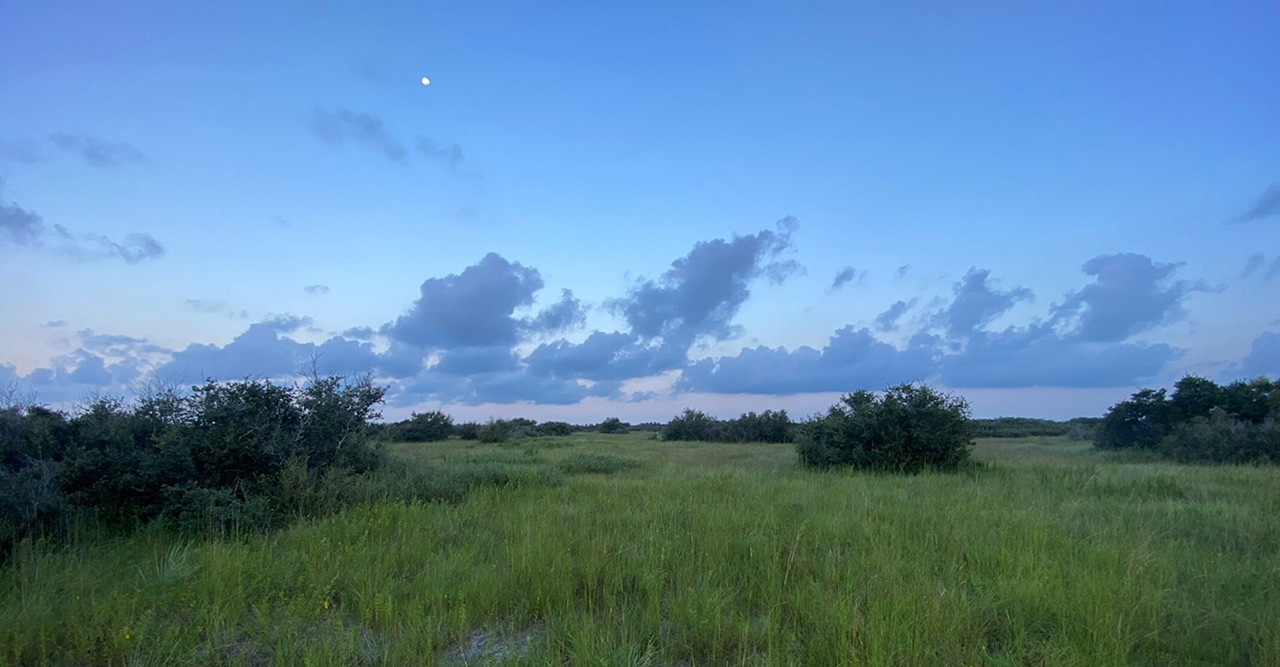
Photo by Carter Crouch/International Crane Foundation
A forward-looking lens was also critical. Staff studied sea level rise models to understand which properties would remain resilient through at least the end of the century. Some low-lying areas along the coast—including areas currently important for Whooping Cranes—will almost certainly be lost as waters rise.
But the selected property sits at a higher elevation and “gains elevation quickly as you move in from the shoreline.” This meant that even with modest sea level rise, the site’s salt marshes—and subsequently, primary Whooping Crane habitat—might actually expand with rising water levels.
“We want this to be a long-term investment,” Crouch said, underscoring that this isn’t about a short term win, but about a strategic safeguard for generations to come.
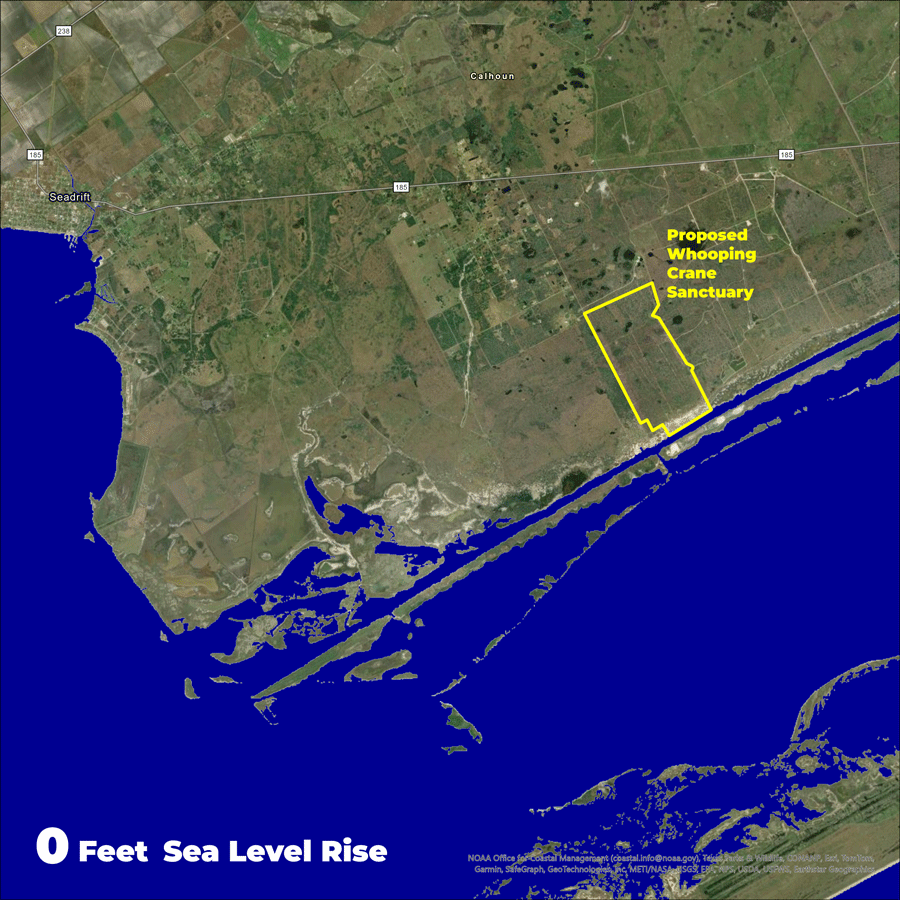
Just how much could sea levels actually rise? This graphic visualizes these impacts in the targeted area at high levels of projected sea level rise. Due to the quickly rising elevation of the proposed property, crane habitat will likely expand, unlike other surrounding areas which will lose crane habitat. Graphic by Ryan Michalesko/International Crane Foundation
Next, the team sought to find a property that also had room for improvement.
“Getting a property that is in perfect shape and has cranes would be great,” Crouch said. “But getting a parcel that already has cranes today and could be better in the future through management and restoration is even more appealing to us. In that way we are not only protecting habitat but increasing it.”
This meant looking for land with prairie and wetland communities that could be restored, and where invasive woody encroachment could be managed back into open habitat.
“The property itself has an excellent prairie vegetation community, but it also has a lot of running live oak and woody plant encroachment,” Crouch said. “There are many nearby examples to look towards for successful restoration of coastal prairie on these sandy soils. We’ve seen excellent responses of both the prairie and Whooping Cranes through restoration. This gives us great optimism about the potential of this property.”
Another key factor was the property’s location within the larger conservation landscape. The property sits within a geography that already includes other private, state, and federal protected lands. Adding this tract strengthens that mosaic, providing cranes with connected areas to move across the landscape.
Benefits Far Beyond Cranes
Beyond Whooping Cranes, the property is also home to other species of greatest conservation need in Texas, proving there are benefits to the project far beyond cranes.
“We very much treat Whooping Cranes as an umbrella species due to their territorial nature and expansive use of habitat,” Crouch said. “Therefore, when we save cranes and the places they live, we save so much more.”
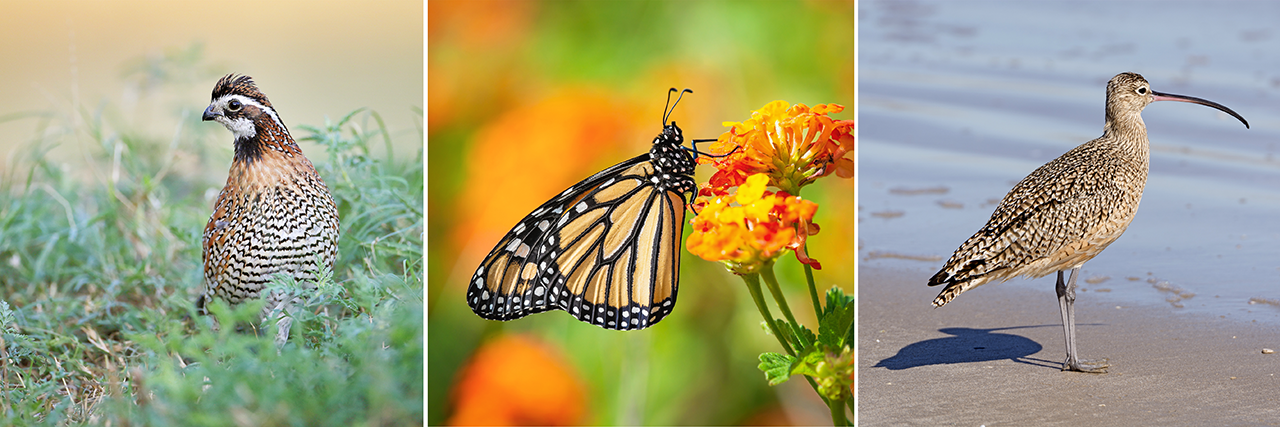
“We know this property is important for Whooping Cranes, but it is also important to many other wetland and grassland dependent species,” he added, referring to the Northern Bobwhite, Loggerhead Shrikes, American Kestrels, Long-billed Curlew, Mottled Ducks, Monarchs, and a long list of other important and declining species that have all been observed on the property.
“Protecting this property and managing a healthy coastal prairie will benefit all of them.”
There are also benefits to people. As climate change evolves, conservation of coastal habitats also expands our resilience to its effects. Coastal marshes buffer storms, including hurricanes. They also filter water and support fisheries that local communities rely on.
A Call to Protect the Future of Cranes
The Whooping Crane has come back from the edge of extinction, but its survival is still far from secure. Today, the greatest threat is simple and stark: the loss of habitat. Without sufficient safe wintering grounds, the cranes’ recovery is likely to slow or stop.
That is why the International Crane Foundation is taking this bold step—purchasing and protecting land on the Texas coast. This property is more than just real estate; it is a living refuge where Whooping Cranes already gather and where, with restoration, their numbers can grow. By saving this land, we are safeguarding an entire ecosystem.
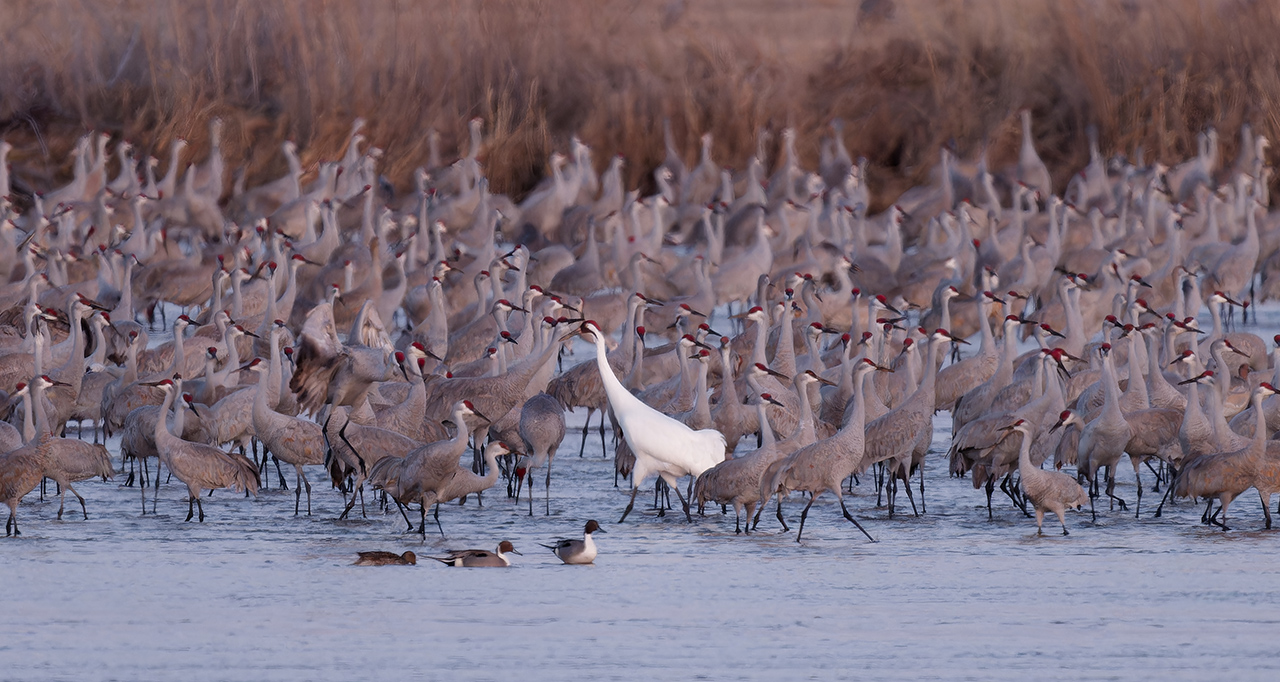
Photo by Tran Triet
Saving Whooping Cranes requires all of us. This effort is ambitious, and it will only succeed if people who care about cranes come together to support it.
You can be part of this legacy. Take this next big step with us. Your donation today will help secure this land, restore it for cranes, and ensure their call continues to echo across the Texas coast.
The cranes are calling. With your support, we can answer.
To learn more or donate, click here.

Story by Ryan Michalesko, Communications and Advocacy Specialist, International Crane Foundation, 608-356-9462 ext. 114
